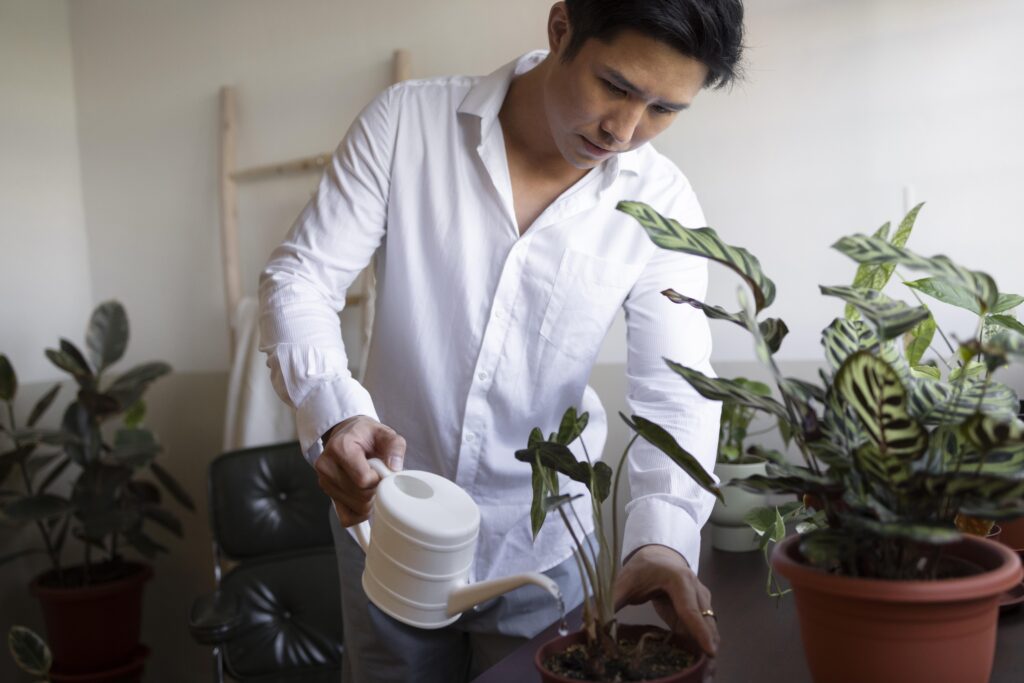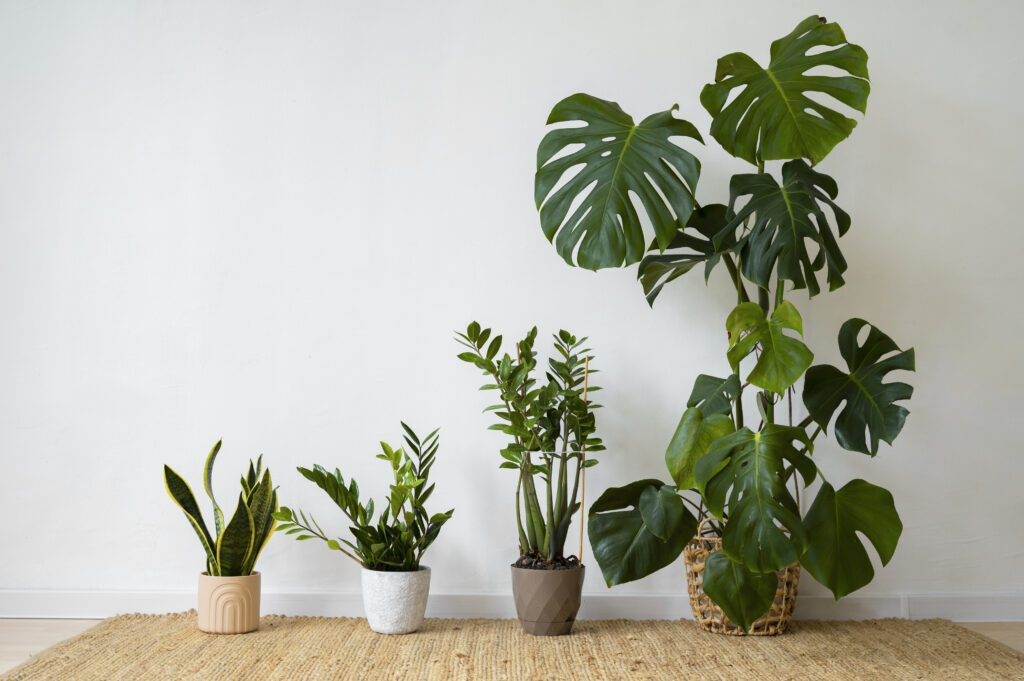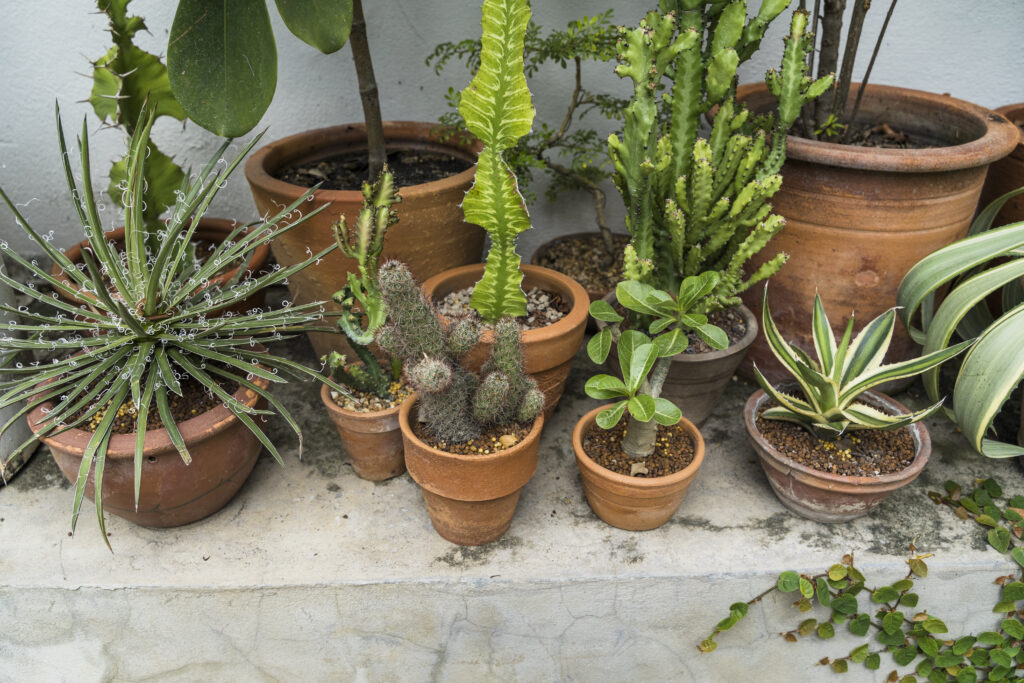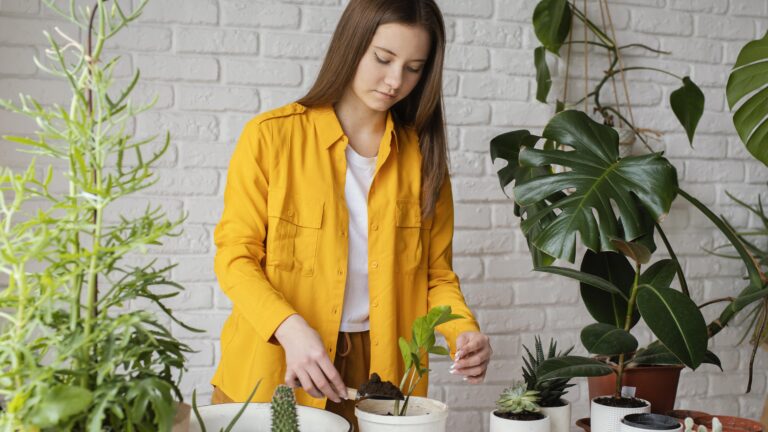Contents
Introduction
If you’re a plant lover, you know how much joy and satisfaction comes from nurturing your green friends. But did you know that just like us, plants need different care depending on the season? Yes, it’s true! Adjusting your plant care routine for changing seasons is key to keeping your plants healthy and thriving year-round.
Imagine this: In winter, your plants might need a lot less water because they’re not growing as quickly. In summer, on the other hand, they might need more hydration and a bit of shade to beat the heat. The changing amount of sunlight and varying temperatures can really throw off your plants’ routine if you’re not prepared.
So, why should you adjust your plant care routine for the seasons? Well, plants have their own natural rhythms and needs that shift with the changing weather. When you understand these shifts and make simple tweaks to how you care for your plants, you’ll help them grow stronger and look their best.
This guide will walk you through everything you need to know about adjusting your plant care as the seasons change. From managing light and temperature to watering and humidity, we’ve got you covered. Whether you’re new to plant care or a seasoned pro, these tips will make it easy to keep your plants happy, no matter what the weather’s doing outside. Let’s dig in and get your plant care routine on point for every season!
Understanding Seasonal Changes
Just like how our clothes change with the seasons, your plant care routine needs to adapt to the weather outside. Plants, though often overlooked, are pretty sensitive to seasonal changes. Understanding these shifts will help you give your plants exactly what they need, when they need it.
Seasonal Light Variations
Think of light as your plants’ version of a daily workout. In summer, they get plenty of sunlight, which fuels their growth spurt. But come winter, the days are shorter, and sunlight becomes scarce. This means your plants might need a bit of help. Moving them closer to windows or using a grow light can make a big difference.
Temperature Fluctuations
Plants are like Goldilocks—they don’t like it too hot or too cold. Summer heat can be overwhelming for them, while winter chills can slow their growth. Knowing your plants’ temperature sweet spots helps you adjust your home environment, like using heaters or air conditioners, to keep them comfortable.
Humidity Levels
Humidity is like the plant equivalent of air moisture. Some plants love a humid environment, like tropical plants, while others prefer a drier climate. During winter, indoor air can get really dry from heating systems. Adding a humidifier or placing your plants on a pebble tray with water can help maintain the right moisture levels.
Water Availability
Watering is one of the trickiest parts of plant care. In spring and summer, plants are in their growing phase and need more water to stay hydrated. In contrast, during fall and winter, many plants slow down and require less water. Adjusting how much you water your plants according to the season helps prevent problems like root rot or dehydration.

By tuning into these seasonal changes, you’ll be better equipped to meet your plants’ needs and keep them thriving all year long. Let’s dive into the nitty-gritty of adjusting your plant care for each season!
Adjusting Light Conditions
Light is like food for your plants—it’s essential for their growth and health. As the seasons change, so does the amount and quality of light your plants receive. Knowing how to adjust for these changes can make a huge difference in keeping your plants happy and vibrant.
Indoor Plants
Indoor plants can get a bit fussy when light conditions shift. During the shorter, darker days of winter, your plants might not be getting enough sunlight. This is where repositioning can help. Try moving them closer to windows where they can soak up every bit of available light. If that’s not possible, consider using a grow light. These handy tools mimic natural sunlight and can keep your plants thriving even in the gloomiest weather.

Outdoor Plants
Outdoor plants have a different set of challenges. In summer, the sun is blazing and can be too intense, potentially causing sunburn on your plants. It’s a good idea to provide some shade during the peak afternoon hours. Shade cloths or even a strategic arrangement of other plants can help protect your outdoor greens from harsh sunlight.

As the seasons change, so do the sun’s position and intensity. Understanding these shifts and adjusting your plant’s placement accordingly ensures they get the right amount of light throughout the year. Whether it’s moving indoor plants or protecting outdoor ones, a little light adjustment goes a long way in keeping your plants healthy and happy.
Temperature Management
Temperature is like the thermostat for your plants. Just as we adjust our home’s temperature to stay comfortable, your plants need the right temperature to thrive. Different seasons can bring drastic changes, so knowing how to manage temperature can keep your green friends in tip-top shape.
Indoor Plants
When it comes to indoor plants, temperature can fluctuate a lot, especially with the changing seasons. In summer, you might be running the air conditioner, while in winter, the heater kicks on. Both of these can impact your plants. To keep them cozy, place your plants away from direct drafts of cold air or hot air vents. Maintaining a steady, moderate temperature will help them grow better and avoid stress.
For wintertime, consider using a space heater or heating pad for particularly sensitive plants, but be cautious of getting too close to the heat source to avoid burning the leaves. During the hot months, make sure your plants aren’t too close to air conditioning units or fans, which can dry out the air and the soil too quickly.
Outdoor Plants
Outdoor plants are exposed to the full range of seasonal temperatures, which can be a bit of a challenge. In the colder months, protect your outdoor plants from frost and extreme cold by using mulch or protective covers. Mulch acts like a blanket, helping to insulate the soil and keep roots warmer.
As summer temperatures rise, make sure your outdoor plants have some shade or are in a location where they won’t get scorched by the intense midday sun. Providing some shade with garden structures or companion plants can help shield them from the harshest heat.
By managing temperature carefully both indoors and outdoors, you’ll help your plants stay comfortable and healthy, no matter what the weather throws at them. Keeping an eye on temperature changes and making small adjustments can make a big difference in your plants’ well-being.
Adjusting Watering Schedules
Watering your plants is a bit like feeding them—getting it just right is key to their health and happiness. But as the seasons change, so do your plants’ watering needs. Here’s how to tweak your watering routine to keep your plants thriving all year round.
Indoor Plants
Indoor plants can be pretty sensitive to changes in water availability. During the warmer months, when your plants are in full growth mode, they’ll likely need more water. You might find yourself watering more frequently as they soak up the moisture and nutrients they need.
But as the seasons shift and temperatures drop, many indoor plants slow down and use less water. Overwatering in winter can lead to root rot, so it’s important to check if the soil is dry before giving more water. A simple moisture meter can help you gauge when your plant actually needs a drink, preventing you from guessing.
Outdoor Plants
Outdoor plants face their own set of watering challenges with the changing seasons. In spring and summer, when rainfall might not be enough, you’ll need to step in with supplemental watering. It’s crucial to adjust your watering schedule to match the weather—if it’s been raining a lot, you might need to cut back on your watering.
In fall and winter, many outdoor plants enter a period of dormancy and need less water. Be cautious not to overwater during these cooler months. Checking soil moisture and adapting your watering routine based on recent rainfall will help you keep your outdoor plants healthy.
By adjusting your watering routine to fit the season, you’ll ensure your plants get the right amount of moisture when they need it most. Keeping an eye on their water needs as the weather changes will help you maintain a happy and healthy garden, whether indoors or out.
Humidity and Air Circulation
Just like people, plants enjoy a comfortable environment, and that includes the right level of humidity and good air circulation. As the seasons change, so do the humidity levels and air flow around your plants. Here’s how to keep your plants feeling cozy and healthy all year long.
Indoor Plants
Indoor plants often struggle with fluctuating humidity levels, especially in winter. When the heater is running, indoor air can get very dry, which isn’t ideal for many plants that love a bit of moisture in the air. To help maintain the right humidity, consider using a humidifier. This adds moisture to the air, making it easier for your plants to stay hydrated.
Another simple trick is to place a shallow tray of water near your plants. As the water evaporates, it increases the humidity around your plants. You can also group plants together to create a mini microclimate with higher humidity.
Good air circulation is also important to prevent problems like mold and mildew. Make sure there’s enough space between plants for air to flow freely. Avoid placing them in cramped or overly damp areas, and consider using a small fan to keep the air moving, especially in winter when indoor air can be stuffy.
Outdoor Plants
Outdoor plants are naturally exposed to varying humidity levels, but they still need a little help sometimes. In humid summer conditions, you might need to ensure good air flow to prevent fungal issues. This can be done by spacing plants properly and avoiding overcrowding.
In contrast, during dry winter months, outdoor plants can benefit from extra moisture. Sprinkling water on the soil around them or using mulch can help retain soil moisture and improve humidity around plant roots.
By paying attention to humidity and air circulation, you’ll help your plants breathe easy and stay healthy throughout the changing seasons. Whether indoors or outdoors, a little extra care with these factors goes a long way in keeping your plants thriving.
Fertilization Adjustments
Fertilizing your plants is like giving them a power-up for growth. But just like with watering and light, the right amount of fertilizer can vary depending on the season. Adjusting how and when you fertilize your plants can help them stay strong and vibrant throughout the year.
Indoor Plants
Indoor plants have different needs throughout the year. During the spring and summer, when they’re actively growing, they need more nutrients to support their growth. This is the best time to fertilize regularly, usually every 4 to 6 weeks, to give them a boost.
As autumn arrives and the days get shorter, your plants’ growth slows down. This is when you should reduce the frequency of fertilizing or switch to a lower-strength formula. In winter, many indoor plants are in a resting phase and don’t need as many nutrients. Over-fertilizing in this period can actually harm your plants, so less is more.
Outdoor Plants
Outdoor plants also have seasonal needs when it comes to fertilization. In the growing season—spring through summer—they benefit from regular feeding. This helps them grow lush and strong, and supports blooming or fruiting. Choose a balanced fertilizer or one suited to your plant’s specific needs.
As fall approaches, it’s time to prepare your plants for the colder months. You can switch to a fertilizer with lower nitrogen content to help them prepare for dormancy. In winter, many outdoor plants won’t need much fertilization since they’re not actively growing. Applying too much can lead to nutrient imbalances or other issues.
By adjusting your fertilization routine to match the seasons, you’ll provide your plants with the right nutrients at the right times. This simple tweak can make a big difference in keeping them healthy and vibrant throughout the year.
Pest and Disease Management
Just like us, plants can catch colds and get pests, but instead of sneezes, they show signs like yellowing leaves or spots. As the seasons change, different pests and diseases become more or less active. Knowing how to manage these issues can keep your plants looking their best all year round.
Indoor Plants
Indoor plants are susceptible to pests and diseases year-round, but different seasons can bring different challenges. In the warmer months, pests like spider mites, aphids, and mealybugs can become more active. Regularly inspect your plants for these unwelcome guests. If you spot any, you can use insecticidal soap or neem oil to keep them under control.
Winter can bring its own set of problems, like fungal infections due to increased humidity from indoor heating. To prevent these issues, ensure good air circulation around your plants and avoid overwatering. If you notice mold or mildew, reduce humidity with a dehumidifier and trim off affected areas.
Outdoor Plants
Outdoor plants face seasonal pest and disease challenges too. In spring and summer, watch out for common pests like caterpillars, aphids, and slugs. Applying organic pest control methods, such as handpicking or using insecticidal sprays, can help manage these problems without harming your garden.
In fall, you might encounter diseases like powdery mildew or rust, especially with the damp weather. To prevent these, keep your garden clean by removing fallen leaves and providing good airflow between plants. Using fungicides can also help if infections occur.
Winter can be tough on outdoor plants, as frost and snow can stress them and make them more susceptible to disease. Protect your plants with mulch or frost covers to shield them from extreme cold and moisture.
By staying vigilant and adjusting your pest and disease management strategies according to the season, you’ll keep your plants healthy and thriving no matter what the weather brings.
Preparing for Seasonal Transitions
As the seasons shift, your plant care routine needs to adapt too. Preparing your plants for each season’s changes helps them stay healthy and ready for whatever the weather throws their way. Here’s how to get your plants ready for each season’s unique conditions.
Spring Preparation
Spring is like a fresh start for your plants. After the cold winter, they’re ready to wake up and grow. It’s a great time to re-pot any plants that have outgrown their containers. Refreshing the soil and giving them a new pot can give them a strong start for the growing season.
Spring is also ideal for pruning. Trim away any dead or damaged parts to encourage new growth. Check if your plants have come out of dormancy and adjust their care accordingly—this might mean increasing watering and starting a regular fertilizing routine.
Summer Care
Summer brings warm temperatures and longer days, so your plants are in full swing. Make sure they’re getting enough water, as they’ll need more hydration in the heat. Consider adding mulch to outdoor plants to help retain soil moisture and keep roots cool.
Provide some shade for plants that are sensitive to intense sunlight. If you’re growing indoors, keep an eye on humidity levels, as the summer heat can dry out the air. Regularly check for pests, as they can become more active during this time.
Fall Adjustments
As fall arrives, plants start to slow down and prepare for the colder months. Reduce the amount of fertilizer you use and cut back on watering, as many plants need less as they enter dormancy. This helps them conserve energy and prepare for winter.
Clear away fallen leaves and debris from around outdoor plants to prevent diseases. For sensitive plants, consider using frost covers or mulching to protect them from the first frosts. It’s also a good time to assess and plan any changes needed for your indoor plants as they adjust to less daylight.
Winter Care
Winter can be tough on plants, especially those that are used to warmer temperatures. For indoor plants, ensure they’re getting enough light, either from natural sources or supplemental grow lights. Avoid placing them near drafty windows or heating vents that can dry them out.
Outdoor plants might need extra protection during winter. Use mulch to insulate the soil and cover plants with frost cloths if necessary. Monitor them for any signs of frost damage and adjust their care to minimize stress during the coldest months.
By preparing your plants for each season’s changes, you’ll help them stay healthy and vibrant all year long. Each transition offers an opportunity to provide the right care and keep your garden or indoor plant collection thriving.
Conclusion
Adjusting your plant care routine for the changing seasons might seem like a lot to manage, but it’s all about keeping your green friends happy and healthy year-round. By paying attention to light, temperature, watering, humidity, fertilization, and pest management, you’re setting your plants up for success through every season.
Here’s a quick recap:
- Light: Shift your plants around to make the most of available sunlight or use grow lights during the darker months.
- Temperature: Keep indoor plants away from drafts and manage outdoor plants with mulch and protective covers to handle temperature changes.
- Watering: Adjust your watering schedule based on the season, making sure to check soil moisture and avoid over or under-watering.
- Humidity and Air Circulation: Maintain proper humidity levels and ensure good air flow to prevent issues like mold and mildew.
- Fertilization: Change your fertilizing routine to match the growth cycle of your plants, providing more nutrients during active growth and less during dormancy.
- Pest and Disease Management: Stay vigilant for pests and diseases, and adapt your management strategies based on the season’s specific challenges.
- Preparing for Seasonal Transitions: Get your plants ready for each season with appropriate care adjustments, from re-potting in spring to protecting against frost in winter.
Remember, every plant is unique and may have its own specific needs. Observing how your plants respond to seasonal changes and adjusting accordingly will help you become a more intuitive and successful plant caregiver.
With these tips, you’re well-equipped to handle seasonal transitions and keep your plants thriving all year long. Happy gardening, and enjoy the beauty and growth of your plants through every season!



